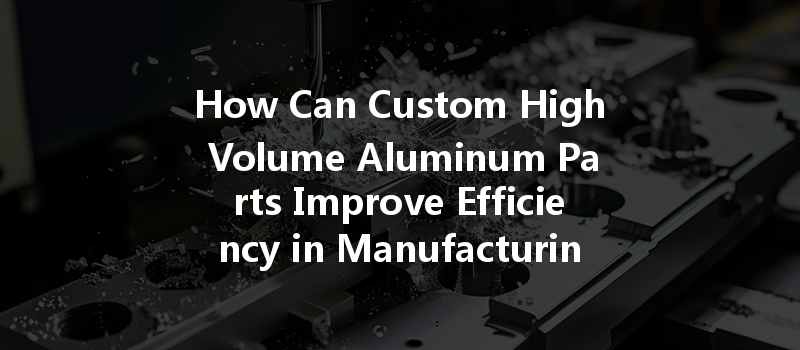When talking about innovation in manufacturing, did you know that the global CNC machining market is expected to reach $100 billion by 2025? This staggering statistic underscores the increasing reliance on precision engineering and custom solutions. In this evolving landscape, custom high volume aluminum parts are becoming increasingly crucial, driving efficiency and sustainability across multiple industries. But how can these parts really make a difference? In this comprehensive blog post, we will explore the benefits, processes, and best practices for integrating custom high volume aluminum parts into your operations.
—
The Importance of Custom High Volume Aluminum Parts
Custom high volume aluminum parts are tailored components designed for specific functions or applications. They are produced in large quantities to meet commercial demands in industries such as automotive, aerospace, electronics, and consumer goods. The distinct advantages of utilizing aluminum—such as its lightweight nature, corrosion resistance, and ease of fabrication—make it a preferred choice for manufacturers looking to optimize their production processes.
Section 1: The Role of Aluminum in Modern Manufacturing
1.1 Overview of Aluminum Properties
Aluminum has several intrinsic properties that make it ideal for high volume production:
1.2 Industries Benefiting from Aluminum Parts
Various sectors benefit immensely from integrating custom high volume aluminum parts into their manufacturing processes, including:
Section 2: The Custom Manufacturing Process
2.1 Designing Custom Parts
The first step in creating custom high volume aluminum parts involves a detailed design process. Utilizing CAD (Computer-Aided Design), designers can create 3D models that encapsulate the specifications needed for manufacturing. Key considerations include:
2.2 Prototyping
Before committing to mass production, prototyping is essential to validate designs. Rapid prototyping techniques such as 3D printing can help create initial models that facilitate testing and evaluation. This step greatly reduces the risk of costly errors in full-scale production.
2.3 CNC Machining Techniques
Custom high volume aluminum parts are often produced using CNC machining, a controlled process that enhances precision. CNC machining encompasses several techniques:
2.4 Quality Control
Quality assurance is paramount in manufacturing processes. Implementing checks at various stages—during design, production, and post-production—ensures that parts meet both industry standards and client specifications. Common quality checks include:

Section 3: Advantages of Custom High Volume Aluminum Parts
3.1 Cost-Effectiveness
Producing custom parts in bulk allows manufacturers to significantly lower the cost per unit. High volume production reduces waste and optimizes material usage, translating to financial savings.
3.2 Enhanced Performance and Durability
Custom aluminum parts are designed with specific applications in mind, leading to improved performance across the board. Their lightweight nature can also contribute to energy savings and can enhance the overall lifespan of the product.
3.3 Flexibility and Scalability
Production processes can be easily adapted to accommodate changing market demands. Custom parts can be scaled up or down without a significant impact on timeframes or costs, allowing businesses to remain agile in a competitive environment.
3.4 Competitive Advantage
By utilizing custom high volume aluminum parts, companies can develop unique products that stand out in their industry. This differentiation not only attracts customers but also fosters brand loyalty.
Section 4: Case Studies
To illuminate the practical applications and successes of custom high volume aluminum parts, consider the following case studies.
4.1 Automotive Industry Case Study
A leading automotive manufacturer adopted custom high volume aluminum components for their vehicles’ engine parts. By doing so, they reduced the overall weight of their cars, improving fuel efficiency by 15% over previous models. Additionally, the streamlined manufacturing process cut production costs by 20%.
4.2 Aerospace Industry Case Study
A major aerospace company implemented custom aluminum parts for its aircraft. By utilizing CNC machining and anodizing processes, they achieved significant reductions in weight without compromising structural integrity. This transition helped the company improve its aircraft’s energy efficiency, leading to lower operational costs and emissions.
4.3 Electronics Industry Case Study
A fast-growing electronics brand sought to manufacture lightweight casings for its devices. By employing custom high volume aluminum parts, the brand not only enhanced the aesthetics of its products but improved thermal management, resulting in better performance and customer satisfaction.
Section 5: Implementing Custom High Volume Aluminum Parts in Your Workflow
5.1 Identifying the Need
The first step in incorporating custom aluminum parts is analyzing your current workflow. Identify potential areas where lightweight, durable components can replace existing materials. A thorough evaluation can help you determine which parts require redesign or enhancement.
5.2 Collaboration with Suppliers
Partnering with reliable manufacturers that specialize in CNC machining and aluminum fabrication is vital. Solid communication and collaboration can help align your design needs with manufacturing capabilities.
5.3 Emphasizing Sustainability
As industries increasingly focus on sustainability, consider integrating eco-friendly practices in your manufacturing process. Choose suppliers who prioritize recycling, energy-efficient practices, and other environmentally sustainable methods.
5.4 Training and Adaptation
Adopting new manufacturing methods may require training for your team. Investing in their education and familiarizing them with the benefits of custom high volume aluminum parts can improve transition and effectiveness.
In summary, custom high volume aluminum parts provide significant advantages across industries, notably enhancing efficiency, durability, and cost-effectiveness. The detailed steps outlined—from design to production and quality control—illustrate the best practices that manufacturers can apply for optimal results.
As we move forward into an era of innovation in manufacturing, the importance of utilizing custom solutions becomes ever more pressing. Custom high volume aluminum parts stand out by providing not just functional benefits but also competitive advantages in today’s rapidly evolving marketplace. Remember, the key to thriving in manufacturing lies in adaptability and the continuous pursuit of efficiency. Investing time and resources into custom solutions could be what sets you apart in your field.
So, why not start exploring the potential of custom high volume aluminum parts for your next manufacturing project? The benefits could very well position your business for success in the ever-competitive manufacturing landscape.



